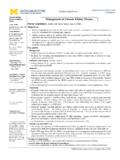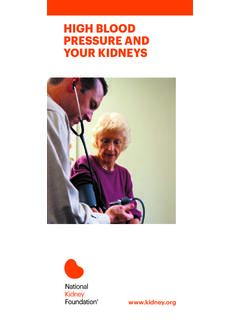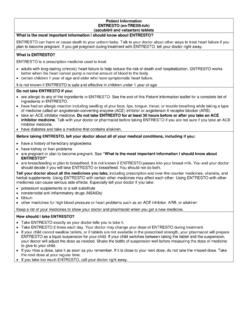Transcription of RISK REDUCTION OF COGNITIVE DECLINE AND DEMENTIA
1 RISK REDUCTION OF COGNITIVE DECLINE AND DEMENTIA WHO GUIDELINESiRISK REDUCTION OF COGNITIVE DECLINE AND DEMENTIA WHO GUIDELINESii Risk REDUCTION of COGNITIVE DECLINE and DEMENTIA : WHO guidelinesRisk REDUCTION of COGNITIVE DECLINE and DEMENTIA : WHO guidelinesISBN 978-92-4-155054-3 World Health Organization 2019 Some rights reserved. This work is available under the Creative Commons Attribution-NonCommercial-ShareAlike IGO licence (CC BY-NC-SA IGO; ). Under the terms of this licence, you may copy, redistribute and adapt the work for non-commercial purposes, provided the work is appropriately cited, as indicated below. In any use of this work, there should be no suggestion that WHO endorses any specific organization, products or services.
2 The use of the WHO logo is not permitted. If you adapt the work, then you must license your work under the same or equivalent Creative Commons licence. If you create a translation of this work, you should add the following disclaimer along with the suggested citation: This translation was not created by the World Health Organization (WHO). WHO is not responsible for the content or accuracy of this translation. The original English edition shall be the binding and authentic edition . Any mediation relating to disputes arising under the licence shall be conducted in accordance with the mediation rules of the World Intellectual Property citation. Risk REDUCTION of COGNITIVE DECLINE and DEMENTIA : WHO guidelines. Geneva: World Health Organization; 2019.
3 Licence: CC BY-NC-SA (CIP) data. CIP data are available at , rights and licensing. To purchase WHO publications, see To submit requests for commercial use and queries on rights and licensing, see Third-party materials. If you wish to reuse material from this work that is attributed to a third party, such as tables, figures or images, it is your responsibility to determine whether permission is needed for that reuse and to obtain permission from the copyright holder. The risk of claims resulting from infringement of any third-party-owned component in the work rests solely with t he us disclaimers. The designations employed and the presentation of the material in this publication do not imply the expression of any opinion whatsoever on the part of WHO concerning the legal status of any country, territory, city or area or of its authorities, or concerning the delimitation of its frontiers or boundaries.
4 Dotted and dashed lines on maps represent approximate border lines for which there may not yet be full mention of specific companies or of certain manufacturers products does not imply that they are endorsed or recommended by WHO in preference to others of a similar nature that are not mentioned. Errors and omissions excepted, the names of proprietary products are distinguished by initial capital reasonable precautions have been taken by WHO to verify the information contained in this publication. However, the published material is being distributed without warranty of any kind, either expressed or implied. The responsibility for the interpretation and use of the material lies with the reader. In no event shall WHO be liable for damages arising from its use.
5 Design and layout: Erica LefstadPrinted in FranceiiiFOREWORD .. vACKNOWLEDGEMENTS .. viACRONYMS .. viiiEXECUTIVE SUMMARY .. x1. INTRODUCTION .. xiv Background and rationale for these guidelines .. Related WHO guidelines and tools .. 3 Target audience .. 4 Goals and objectives .. Guiding principles .. 52. GUIDELINE DEVELOPMENT PROCESS .. 62 .1 Guideline development group .. Declarations of interest by the GDG members and external reviewers .. Collaboration with external partners .. Identifying, appraising and synthesizing available evidence .. Decision-making during the GDG meeting .. Document preparation and peer review .. 113. EVIDENCE AND RECOMMENDATIONS.
6 123 .1 Physical activity interventions .. Tobacco cessation interventions .. Nutritional interventions .. Interventions for alcohol use disorders .. COGNITIVE interventions .. Social activity .. Weight management .. 29 Management of hypertension .. 32 Management of diabetes .. 35 3 .10 Management of dyslipidaemia .. 38 3 .11 Management of depression .. 40 3 .12 Management of hearing loss .. 434. IMPLEMENTATION CONSIDERATIONS .. 465. PUBLICATION, DISSEMINATION AND EVALUATION .. Publication and dissemination .. Monitoring and evaluation .. Implications for further research .. Future review and update .. 51 REFERENCES .. 52 ANNEX 1: GUIDELINE DEVELOPMENT GROUP MEMBERS.
7 60 ANNEX 2: ASSESSMENT OF CONFLICT OF INTEREST .. 62 ANNEX 3: SCOPING QUESTIONS .. 67 ANNEX 4: EVIDENCE REVIEW METHODOLOGY .. 72 WEB ANNEX: EVIDENCE PROFILES (WHO/MSD/ ); REDUCTION / .. 77iiiCONTENTSiv Risk REDUCTION of COGNITIVE DECLINE and DEMENTIA : WHO guidelinesvFOREWORDD ementia is a rapidly growing public health problem affecting around 50 million people around the world. There are nearly 10 million new cases every year and this figure is set to triple by 2050. DEMENTIA is a major cause of disability and dependency among older people and can devastate the lives of affected individuals, their carers and families. Additionally, the disease inflicts a heavy economic burden on societies as a whole, with the costs of caring for people with DEMENTIA estimated to rise to US$ 2 trillion annually by there is no curative treatment for DEMENTIA , the proactive management of modifiable risk factors can delay or slow onset or progression of the disease.
8 In May 2017, the Seventieth World Health Assembly endorsed a Global Action Plan on the Public Health Response to DEMENTIA 2017 2025, urging Member States to develop, as soon as feasible, ambitious national responses to address this challenge. DEMENTIA risk REDUCTION is one of the seven action areas in the global action plan. These new WHO guidelines provide the knowledge base for health care providers, governments, policy-makers and other stakeholders to reduce the risks of COGNITIVE DECLINE and DEMENTIA through a public health approach. As many of the risk factors for DEMENTIA are shared with those of non-communicable diseases, the key recommendations can be effectively integrated into programmes for tobacco cessation, cardiovascular disease risk REDUCTION and nutrition.
9 I urge all stakeholders to make the best use of these recommendations to improve the lives of people with DEMENTIA , their carers and their Ren MinghuiAssistant Director-General for Universal Health Coverage/Communicable and Noncommunicable Diseases, World Health Organizationvi Risk REDUCTION of COGNITIVE DECLINE and DEMENTIA : WHO guidelinesGUIDELINE DEVELOPMENT GROUPC hair: Martin Prince, King s College, London, United : Charles Alessi, Public Health England, London, United Kingdom; Kaarin J Anstey, University of New South Wales, Sydney, Australia; Kimberly Ashby-Mitchell, Caribbean Public Health Agency, Port of Spain, Trinidad and Tobago; Adelina Comas-Herrera, London School of Economics, London, United Kingdom; Amit Dias, Department of Preventive and Social Medicine, Goa Medical College Bambolim, Goa, India; Cleusa P Ferri, Federal University of S o Paulo, S o Paulo, Brazil; Riadh Gouider, Razi Hospital, Faculty of Medicine, Tunis, Tunisia; Shinya Ishii, Ministry of Health, Labour and Welfare, Tokyo, Japan; Yves Joanette, Canadian Institutes of Health Research, Government of Canada; Joseph Kibachio, Ministry of Health, Nairobi, Kenya; Miia Kivipelto, Karolinska Institutet, Stockholm, Sweden; Shanthi Mendis, Colombo, Sri Lanka; Ayesha Motala, University of KwaZulu-Natal, Durban, South Africa.
10 Ronald C Petersen, Mayo Clinic, Rochester, United States of America; Dorairaj Prabhakaran, Public Health Foundation of India, New Delhi, India; Suzana Shahar, Universiti Kebangsaan Malaysia, Selangor, Malaysia; Ameenah Bibi Mia Sorefan, Ministry of Health and Quality of Life, Quatre-Bornes, Mauritius; Kusumadewi Suharya (Dy), Alzheimer s Disease International, Jakarta, Indonesia; Huali Wang, DEMENTIA Care & Research Center, Peking University Institute of Mental Health, Beijing, China. Grade methodologist: Corrado Barbui, University of Verona, REVIEW GROUPA bdullah Al Khatami, Ministry of Health, Saudi Arabia; Emiliano Albanese, Universit della Svizzera italiana, Switzerland; Alistair Burns, University of Manchester, United Kingdom; Linda Clare, University of Exeter, United Kingdom; Jacqueline Dominguez, Institute for DEMENTIA Care Asia, Quezon City, Philippines; Hillary Doxford, 3 Nations DEMENTIA Working Group, United Kingdom; Mael nn Guerchet, Global Observatory for Ageing and DEMENTIA Care, King s College London, United Kingdom; Mariella Guerra, Institute of Memory, Depression and Related Disorders, Lima, Peru.














